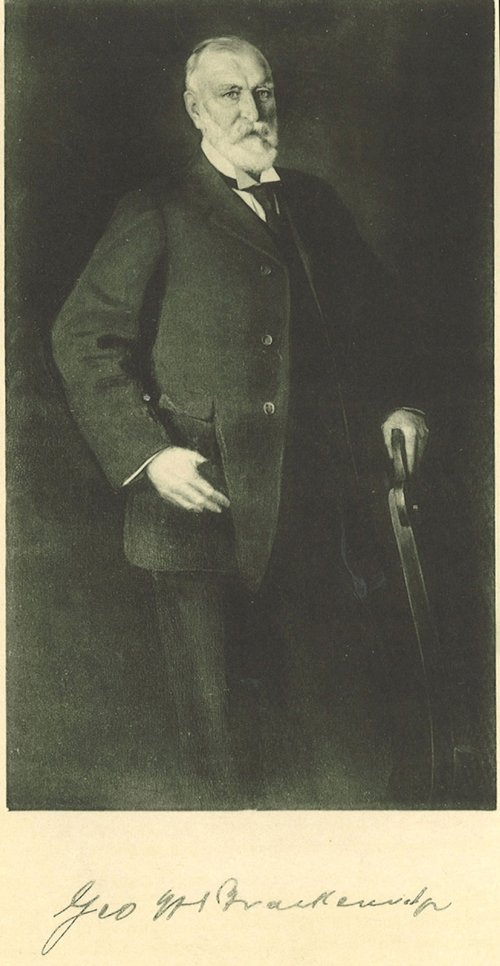Dueling Donors: The Brackenridge-Littlefield Feud
 |
| George Brackenridge. |
Being named after a revered leader must bring with it a certain amount of pressure to live up to the honor. As it happens, two of The University of Texas's most prominent benefactors were thus christened--George Washington Brackenridge (1832-1920) and George Washington Littlefield (1842-1920). Perhaps their stately shared moniker offers some explanation for the rivalry that evolved between the two men, a battle of wills that helped make UT Austin what it is today.
George Brackenridge made his fortune mostly in cotton and banking. Between 1886 and 1919, the San Antonio resident was appointed and re-appointed to the University of Texas Board of Regents by seven Democratic governors, despite his Republican leanings. As chairman of UT's land committee for many of those years, Brackenridge oversaw management of the University's 1 million acres.
Major Littlefield's life was remarkably similar to Brackenridge's, but there were a few noteworthy differences. Born in Indiana, Brackenridge came to Texas at the age of 21, while Littlefield moved to Texas from Mississippi with his family when he was eight. During the Civil War, Brackenridge served the U.S. as a treasury agent, while Littlefield chose to fight for the South, rising swiftly through the Confederate cavalry until he was seriously wounded in battle in 1864. Like Brackenridge, he turned to the land and then to banking after the war.
Driving cattle from Texas to Kansas gave Littlefield the resources to acquire ranches throughout West Texas and New Mexico. In 1883, the first year of classes at The University of Texas, he made Austin his permanent home. He was appointed to the Board of Regents in 1911 and served for the rest of his life.
 |
| George Littlefield. |
Brackenridge and Littlefield's shared connection with the University fueled a rivalry that lasted until their deaths in 1920. While their competition was fierce, most accounts indicate that Brackenridge held less animosity for Littlefield than vice versa. Brackenridge even exhibited a grudging respect for the major, at one point writing, "I am glad to know that Mr. Littlefield does not belong altogether to anyone but is showing some independence. He is a strong, if somewhat rough, character--not unlike myself."
One of Brackenridge's first major gifts to UT, in 1890, was the $18,000 necessary to construct the first men's dormitory on campus. Much to Littlefield's consternation, the building came to be known as B. Hall in honor of Brackenridge.
The competition to be the University's most important donor intensified when Brackenridge gave the University $25,000 to establish a loan fund for women students in architecture, law, and medicine. Not to be outdone, Littlefield immediately gave his own $25,000 gift to establish a collection of Southern history. This pattern characterized the pair's UT philanthropy for the rest of their days.
Perhaps no episode captures the essence of their feud better than Brackenridge's 1910 donation of 500 acres along the Colorado River, where he hoped to see the campus relocated. Littlefield was against the proposed move from the beginning and was joined in his opposition by the landlords and merchants surrounding the original campus. Seeing that Littlefield was in poor health, Brackenridge's strategy was to wait until the major died and then round up support for his plan. Littlefield lived another decade, however, and even in death he managed to foil Brackenridge's plan.
Littlefield's estate plan included more than $1 million for the University--provided the campus stayed where it was. If it changed sites, most of these assets would be lost. The campus stayed put, and Littlefield's bequest helped to fund several projects, including the current Main Building and the ornate veteran's memorial fountain on the South Mall that bears his name. Brackenridge, irked by Littlefield's coup, fell ill and died a month after his rival, leaving his entire estate to relatives.
Both men, despite their mutual disdain, were extraordinary businessmen and believed their good fortune should be shared. Their philanthropy extended near and far at a time when tax advantages were few. They lived up to their celebrated name, and each left his own lasting legacy.
By Jamey Smith, from Texas Tribute (Spring 1997)
You may also read more about Littlefield and Brackenridge on the Department of Integrative Biology's History Project website: "The Two Georges"



